6 Software Testing Methodologies to Explore
The key differentiators for the success of an app-first company are staying ahead of the competition and consistently delivering top-notch quality. Unsurprisingly, teams are constantly searching for the most effective testing approaches to enhance their QA strategy and elevate the quality of their products. Software testing methodologies serve as the critical processes that ensure the delivery of well-tested products, even in the face of lightning-fast Software Development Life Cycles (SDLCs).
But how does one determine the software testing methodology for their specific needs? What does each methodology involve, and what advantages do they offer? Continue reading to uncover the answers.
Understanding software testing: Methodologies vs. Types
To grasp the full scope of software testing, we need to distinguish between two key concepts: software testing methodologies and types of software testing. Firstly, software testing methodologies, such as Agile, primarily focus on the procedural aspects of testing within the project management framework. They outline the approach and philosophy guiding the testing process in relation to the overall software development lifecycle.
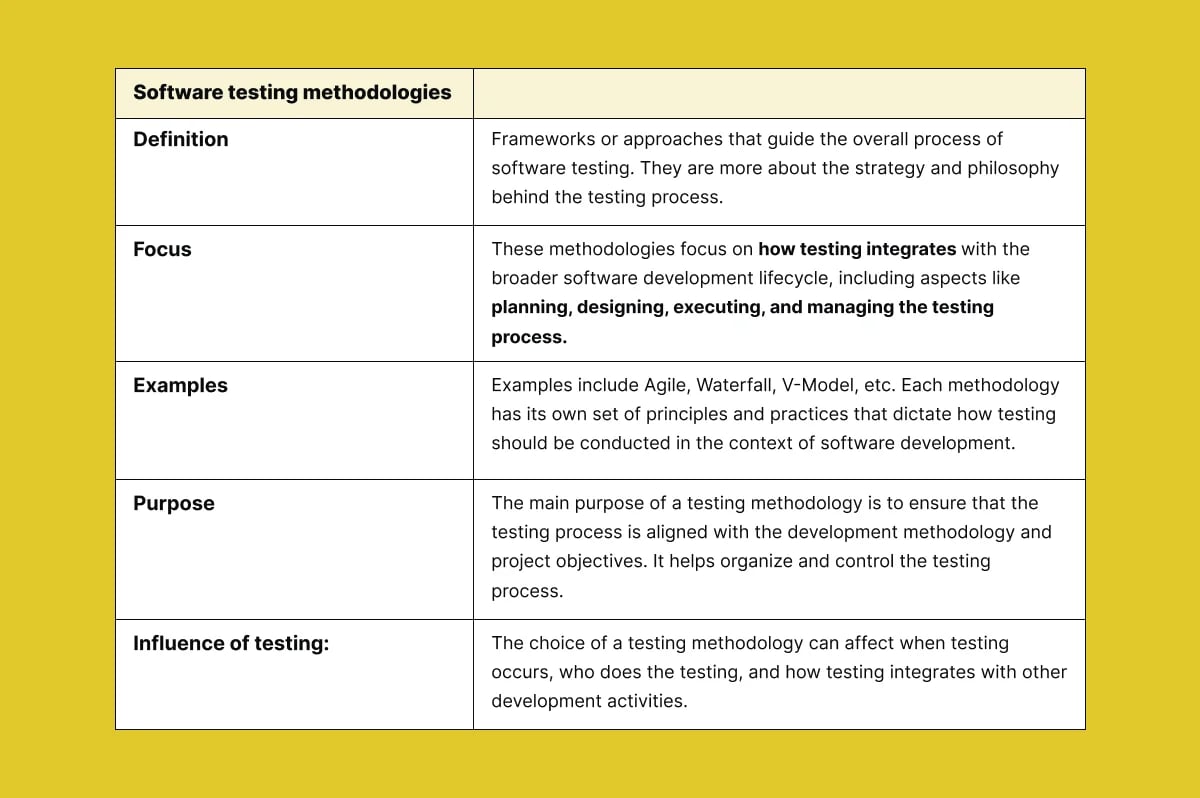
Secondly, various types of software testing, like smoke testing, delve into the technical specifics of the testing activities. These types represent the diverse techniques and procedures used to verify different aspects of the software.
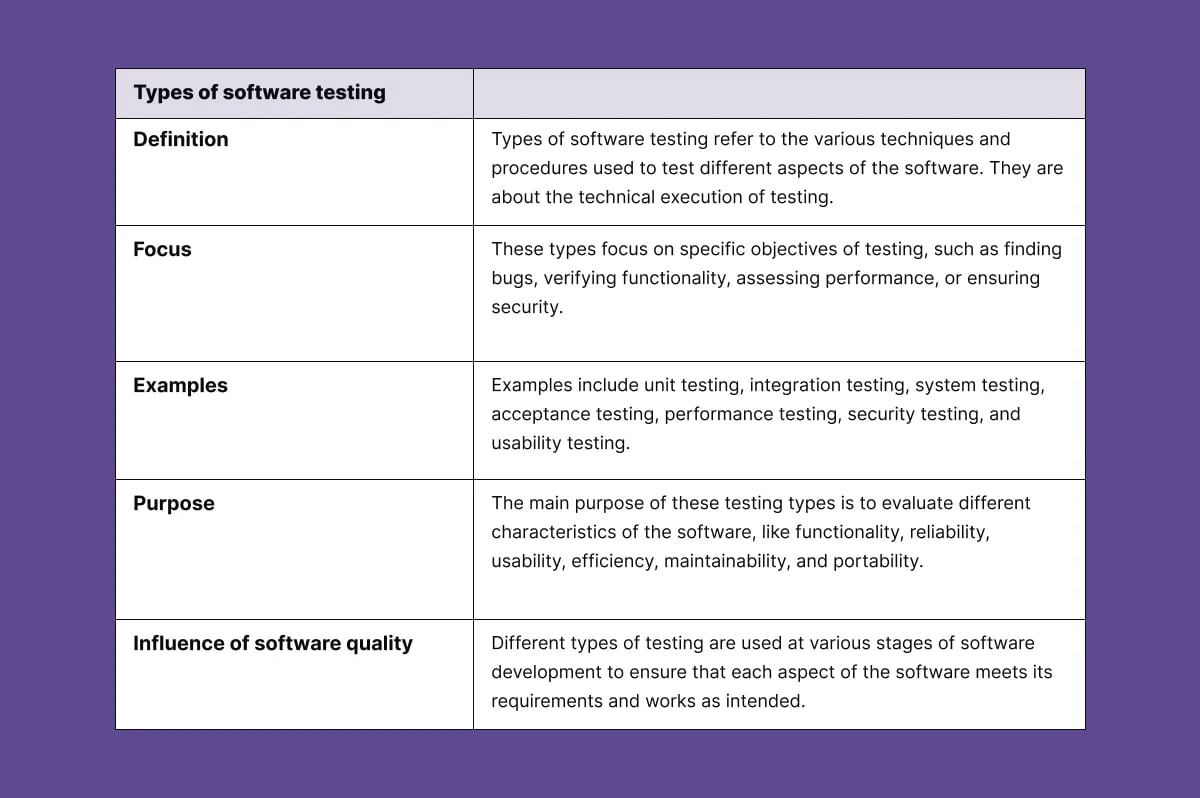
The categorization of these testing types can be viewed from multiple angles. For instance, when classified based on the timing of execution, we get a distinct set of testing methods. Alternatively, when categorized by the level of testing (unit, integration, system, etc.), a different grouping emerges.
- Software testing methodologies: About the 'how' — the approach and strategy behind the testing process.
- Types of software testing: About the 'what' — the specific techniques and objectives of testing different software aspects.
This article will focus on the predominant software testing methodologies employed by in-house QA teams and specialized software testing companies. We'll explore how these methodologies shape the testing landscape and contribute to efficiently delivering high-quality software.
Waterfall Method
This software development model is sequential. The next step only begins after the previous step is completed. The process might look a little something like the diagram below:
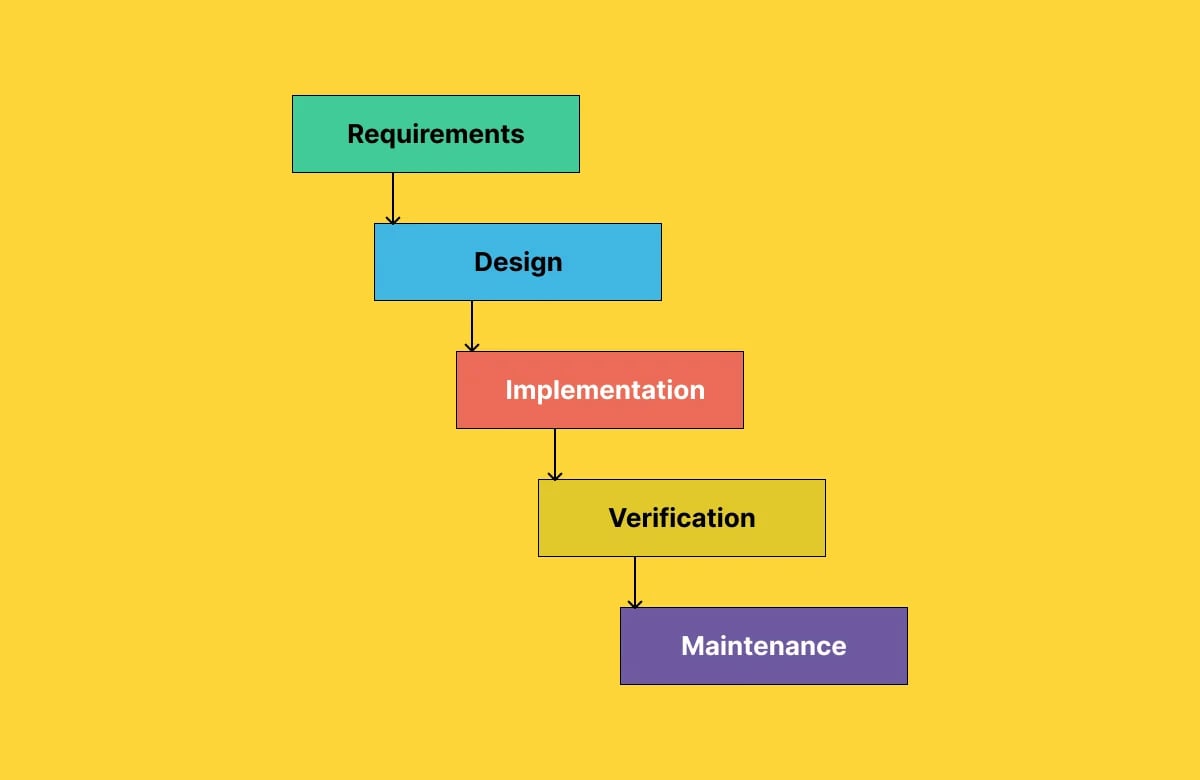
This method has been around since 1970 when Winston Royce introduced it. It works by having no overlap in stages and following a straightforward, carefully planned journey. Let's break it down.
1. Requirements
- This part is all about gathering the requirements for the product or update. What are the key functions? How should it behave?
2. Design
- Decide how the code will be written. Focus on the design of the product.
3. Implementation
- Build the product. Write the code.
4. Verification
- Test, test, test.
5. Maintenance
- Release the product into the wild. Then, be ready for any bug fixes, updates, or changes.
What are the benefits?
In reality, this method doesn't allow a lot of wiggle room. For that reason, it is extremely useful for small projects where requirements are clearly defined. The waterfall methodology can be very restrictive for anything bigger, like a full product launch. If you want to release a simple update with a clear set of instructions behind it, however, waterfall can help.
Moreover, testing is only the fourth step out of five, pushed right down the priority list. This method does not prioritize QA, and, especially when 80% of bugs are introduced at the design stage of the typical SDLC, leaving quality as an afterthought could be a costly mistake. As software testing methodologies go, it might not be your preferred option if you need to launch a high-quality product.
Limitations
- This model represents a fixed methodology that must be followed without deviation.
- Any minor changes to the methodology could result in significant additional costs.
Agile Methodology
Agile testing couldn't be further from the strict process of waterfall. Agile testing operates under the philosophy that testing is a crucial part of development and just as important as the coding stage. In agile, testing is integrated directly into the development process to discover bugs as early and as often as possible. As a result, testers can identify problems at every point in the development process, moving the product quickly toward release.
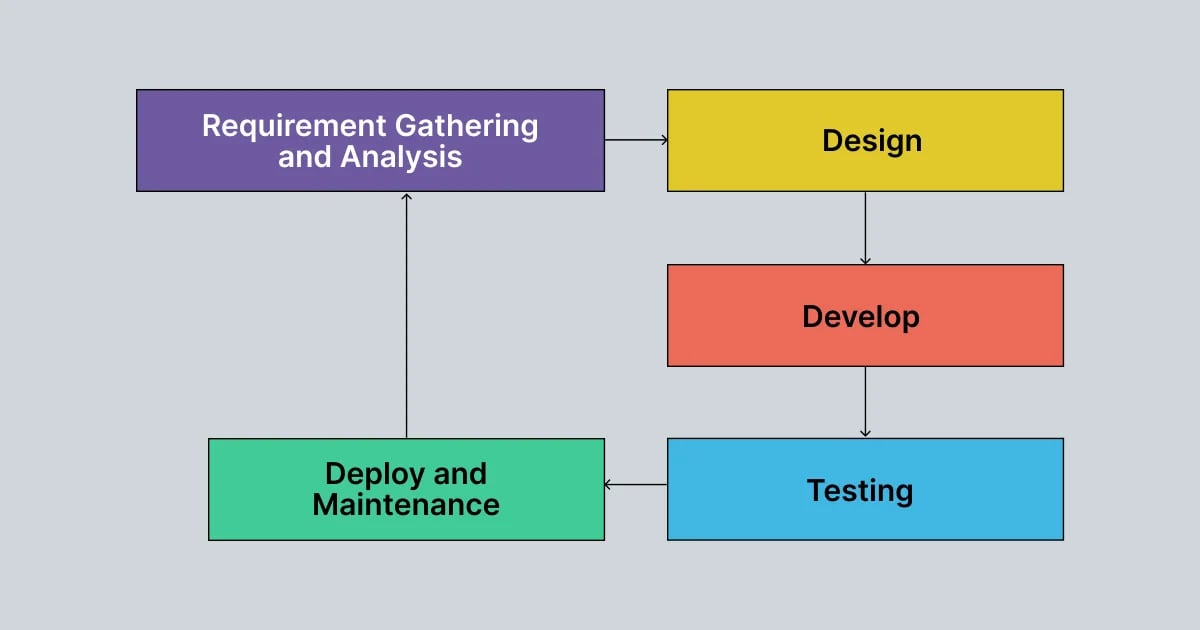
What are the benefits?
The agile methodology makes your SDLC fluid and your team more adaptable. The involvement of QA from the word 'go' means that your product will be well-tested and of better quality.
But don't just trust us. We spoke to the experts, too.
Eugene Naydenov, CTO at Competera uses agile to deliver quality at speed. They said:
“Continuous testing is an integral part of the agile development process. We ship high-quality small increments and gather early customer feedback, which helps us prioritize our next steps. Thus, we minimize risks by failing fast and cheaply and avoid investing too much in the initiatives that do not benefit our customers.”
Victor Lavrentyev, CTO at Orangesoft also sings the praises of the agile approach.
“The main benefits of the agile approach are:
- The ability to quickly respond to possible changes
- Testing documentation is simplified, but always up to date (for example, QA-Checklists)
- Continuous testing and, as a result, higher quality
- Convenience for the work of developers and managers who are constantly in touch with a client or a product owner
- Perfect for startups and fast-growing projects.”
What are the benefits?
- Poor prioritization in planning can lead to inefficiencies in documentation.
- Frequent back-and-forth interactions with customers might cause delays in project delivery.
Iterative Development
In iterative development, a large project is broken down into smaller, manageable chunks. Each 'chunk' is subjected to a number of iterations of the waterfall model. It's almost as if you run several different SDLCs within a wider project, and each iteration contains a waterfall methodology. It looks a little bit like this:
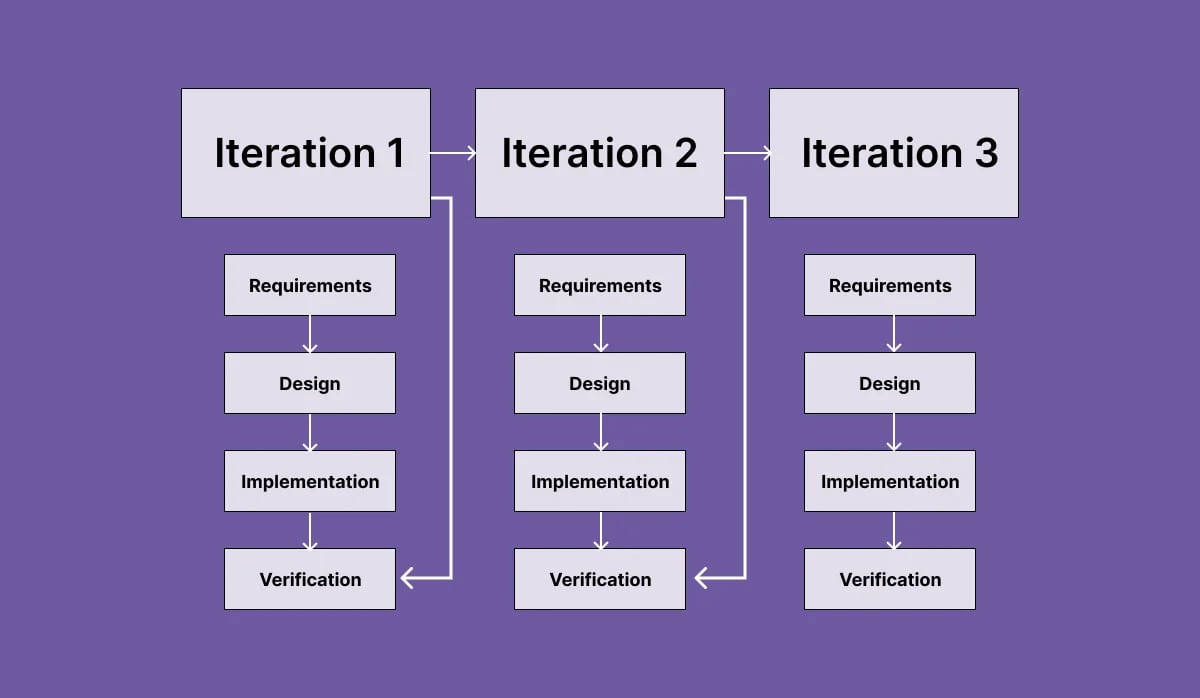
As soon as one iteration is completed, the entirety of the software is subjected to testing (verification). Then, feedback from the tests is incorporated into the next cycle. As the iterations progress, the time spent testing can be reduced due to experience gained from previous iterations. It means you have more flexibility to test earlier in the process and test each iteration thoroughly rather than conducting a considerable amount of testing right at the end of your SDLC.
What are the benefits?
A considerable benefit of using this method is that testing feedback is available at the end of each iteration - it means that you are testing more regularly than in a method like a waterfall, allowing the results to inform your decision-making. Although iterative development does not quite abide by the rules of continuous testing, it does bear similarities to the agile methodology. You test earlier on in the SDLC and incorporate feedback from your tests into the development process. It means you are emphasizing the value of QA and allowing it to influence part of your decision-making.
Limitations
- Each round of feedback noticeably escalates overall communication overhead.
- Additionally, the iteration cycle is rigid and does not allow overlapping phases.
Verification and Validation Model (V-Model)
The V-Model, an extension of the Waterfall model, is particularly suited for small projects with clearly defined requirements. This model adopts a 'V-shaped' approach, segmented into coding, verification, and validation phases. Each development stage in the V-Model is closely paired with a corresponding testing activity, enabling early detection of defects at each phase.
This concurrent development and testing process allows for immediate testing of each completed part of the product, facilitating early modifications and leading to more efficient resource and time management.
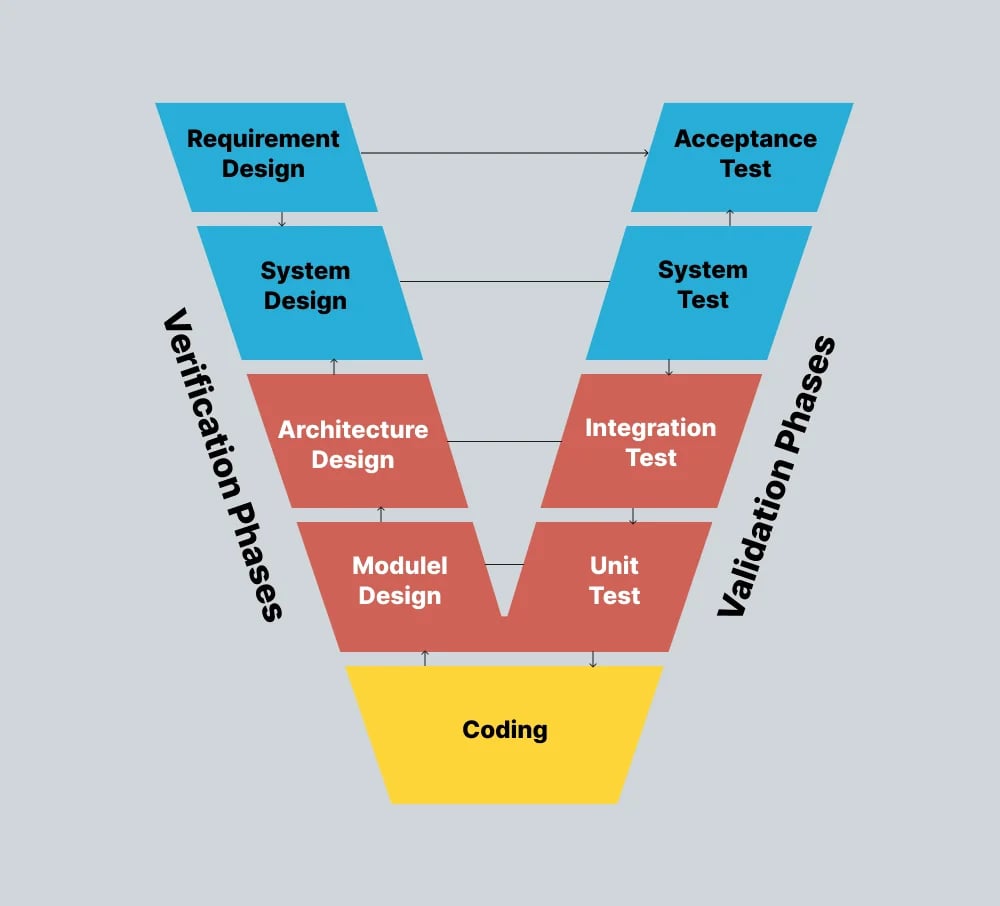
What are the benefits?
- It is ideal for small-scale projects with well-integrated requirements, offering more cost-effectiveness compared to the traditional Waterfall model.
- Ensures thorough testing and validation at each phase, aiding in early error detection within the Software Development Life Cycle (SDLC).
Limitations
- It lacks flexibility in addressing bugs identified during the testing phase.
- It does not provide a predefined strategy for rectifying identified software issues.
Spiral Model
The Spiral Model in Quality Assurance blends elements from both the Waterfall and Iterative development methodologies. It aligns with the incremental approach but emphasizes risk analysis more. Key phases of the Spiral model include:
- Planning
- Risk analysis
- Evaluation
- Engineering, etc.
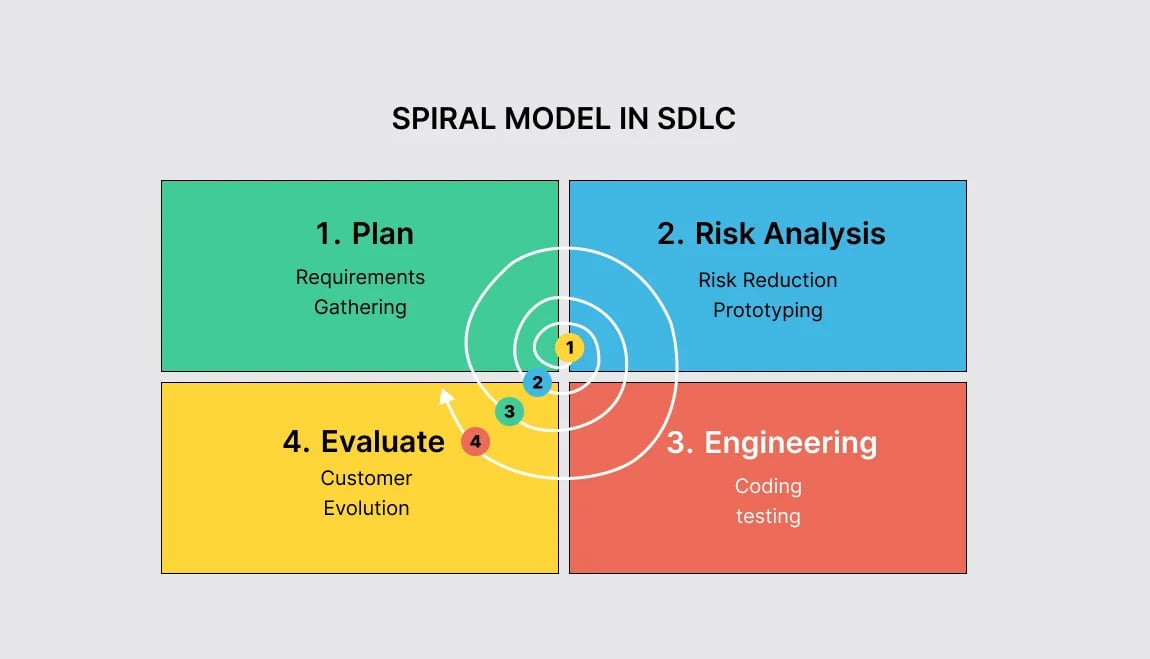
What are the benefits?
- Utilizes a time-boxed approach in each incremental phase, effectively minimizing risks in software projects.
- It offers strong documentation support and is particularly effective for larger, more complex projects.
Limitations
- Due to its complexity and scale, it is not cost-effective or practical for smaller projects.
- The model presents difficulties when applied to legacy systems.
Extreme Programming (XP) Model
The Extreme Programming (XP) model is an Agile-based approach where developers write simple code to gather user feedback rapidly. It divides the project into smaller, manageable segments, with each section being developed sequentially. This model is particularly effective in scenarios where user requirements are constantly changing.
In XP, collaboration is key, involving two teams working in tandem: one focuses on coding while the other promptly reviews it. A phase in this methodology is considered complete only when the code is both well-written and thoroughly tested, allowing Quality Assurance teams to produce high-quality code through meticulous scrutiny.
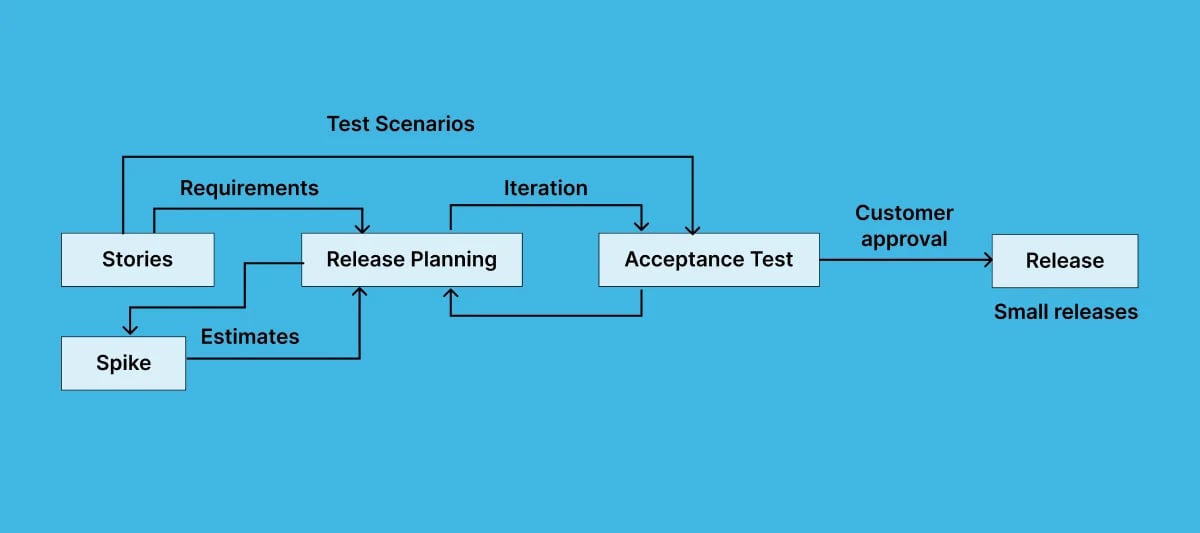
What are the benefits?
- It is ideal for clients with evolving or unclear software concepts, as it allows for flexible programming and frequent revisions.
- It ensures high-quality software through continuous testing and integration of small releases.
Limitations
- Significant time investment is required for ongoing discussions between the development team and clients.
- Frequent and substantial changes can adversely affect the application's productivity.
Choosing the right software testing methodology for you
There are so many methodologies to choose from regarding software development. Regarding the testing part of the process, you need to consider your requirements, project size, scope, and budget.
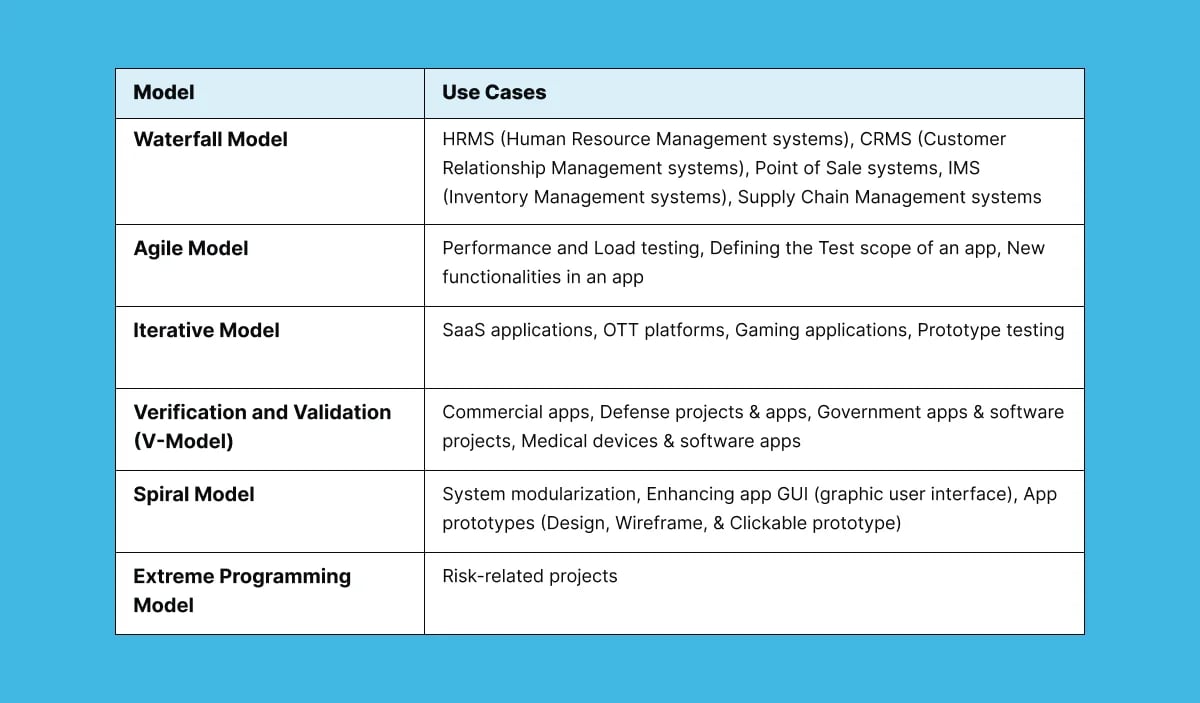
For smaller projects with a clear scope, methods like waterfall can be extremely beneficial. That's because your team is following a straightforward process with a degree of understanding about where the process will lead. But typically, for bigger projects, agile methodologies can have some substantial benefits.
Introducing testing early into your SDLC means you will catch bugs earlier on. It enables you to incorporate testing feedback into the design and build stages and achieve a better quality product overall as you focus on making QA a priority.
Each project is unique. So consider your options, assess your scope, and use our guide to decide whether software testing methodology suits you. Speak to one of our experts today to discover how to supercharge your QA strategy and ensure you are delivering the best possible product.
FAQ
How do software testing methodologies impact software quality?
The choice of a testing methodology can significantly affect the software's final quality. Different methods offer various approaches to identifying and fixing defects, thus influencing the software's reliability, usability, and performance.
Can software testing methodologies be combined or customized?
Yes, it's common to tailor methodologies or combine elements of different methodologies to fit a project's specific needs and context.
Are there specific methodologies for different types of software?
While some methodologies are more prevalent in certain domains (e.g., Agile in web development), the choice often depends more on the project size, complexity, and team preference than on the type of software.
Keep learning
The only software testing checklist you need
8 Best software testing blogs to follow in 2025
The only iOS app testing checklist you'll ever need

